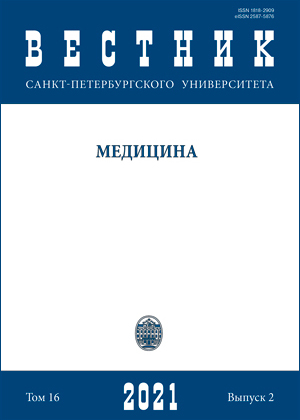Коморбидные расстройства у молодых лиц с вертеброгенной патологией и диспластическим фенотипом
DOI:
https://doi.org/10.21638/spbu11.2021.203Аннотация
Pathological changes in the spine are often accompanied by pain syndrome at a young age. However, the significance of comorbid disorders in the formation and course of vertebrogenic pain syndrome has not been studied enough.The objective of the article to clarify the role of comorbid disorders in young adults with unclassified dysplastic phenotype in the formation of vertebrogenic pain syndrome. 61 male patients from 18 to 26 years old with pain syndrome in the spine were examined. Depending on the presence of signs of a dysplastic phenotype the patients were divided into two groups. The first group included 28 patients (median age 22 (21; 23) years), the second group consisted of 33 people (median age 23 (19; 24) years). All patients underwent a comprehensive examination, including neurological and somatic examination, neuroradiological, ultrasound and psychological methods of investigation, also took into account clinical and anamnestic data. Pain syndrome, the state of the autonomic nervous system and the presence of signs of a dysplastic phenotype were assessed using scales and indices. Statistical data processing was performed using the STATISTICA 10.0 program. Differences were considered statistically significant when p < 0.05. According to neuroimaging data, signs of widespread dysplastic and more pronounced scoliotic and kyphoscoliotic changes of the spine, vertebral anomalies, segmental instability were authentically more frequent in patients with the unclassified connective tissue dysplasia phenotype (p<0,05). They had more severe vertebrogenic pain syndrome, which was more intense and long-lasting and was on the background of a greater neurological deficit with autonomic lability and psychopathological disorders, headaches, somatic dysfunction with a prevalence of diseases of the bronchopulmonary system and ENT organs in the control group (p<0.05). Research findings allow us to consider the prevalence of pathological changes in the spine, depressive disorders, somatic and cerebral burden as factors contributing to the formation of pain syndrome in patients with vertebrogenic pathology and connective tissue insufficiency.
Ключевые слова:
young age, pain syndrome, comorbid diseases, connective tissue dysplasia, spine
Скачивания
Библиографические ссылки
References
Загрузки
Опубликован
Как цитировать
Выпуск
Раздел
Лицензия
Статьи журнала «Вестник Санкт-Петербургского университета. Медицина» находятся в открытом доступе и распространяются в соответствии с условиями Лицензионного Договора с Санкт-Петербургским государственным университетом, который бесплатно предоставляет авторам неограниченное распространение и самостоятельное архивирование.




